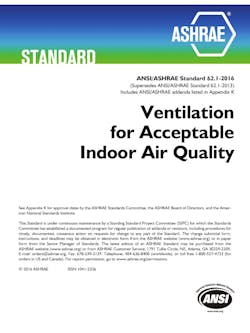Strategies for Reducing Microbial Contamination in HVAC Systems
By Devyn Barrie
With flu season well underway across North America, there are valid questions on the role that HVAC plays in reducing or worsening transmission of pathogens. When half the office is coughing and hacking, what can HVAC designers and operators do to prevent systems from worsening the spread?
HVAC, of course, plays a significant role influencing the suitability of spaces for human use. Ideally, an HVAC system will be the source of the best quality air for any given space by filtering, conditioning and blending in fresh outdoor air before delivering to the breathing zone. In most cases, this is easily achieved and following ASHRAE Standard 62.1 will typically yield great indoor air quality. But biological contamination is not as easily addressed and can pose a significant threat to IAQ.
Fortunately, there are some strategies and at least one effective technology that HVAC designers and operators can use to minimize the risk posed by contaminated airstreams.
This article is geared towards light-commercial HVAC application for traditional indoor spaces like offices, where many people spend much of their day, although these concepts may be applied for other applications. ASHRAE Standard 62.1 contains ventilation standards for these spaces that “are based on chemical, physical, and biological contaminants that can affect air quality.” Specifically, it requires HVAC equipment to use airstream surfaces that resist mold growth. They also must use at least MERV-8 filters upstream of the evaporator coil to ensure most particulates and mold spores get removed from the airstream.
Standard 62.1 prescribes fresh air introduction for spaces but has a footnote: the tables prescribing outdoor air rates allow for acceptable IAQ but do not address airborne transmission of pathogens. ASHRAE Standard 170 provides for deeper consideration of biological contamination in HVAC systems, but that standard is intended for health care facilities rather than traditional indoor spaces.
Limiting infections
ASHRAE’s position document on airborne transmission recommends the latest standards be followed, noting that there are certain diseases where ventilation is a useful partner in controlling spread. For a space like an office, a great way to limit spread of infection is to keep the area around room temperature and at 50% RH — this is the Goldilocks Zone where research has shown it is not too dry nor too moist to promote maximum spread.
For example, a 2007 study published in PLOS Pathogens experimented with transmission of flu between guinea pigs and found that temperature and RH influences the frequency of contracting the virus. At 20°C and 50% RH, the frequency of infection was lowest. RH above 80% also appeared to help curtail spread, although most people would find this level to be uncomfortable and it would also increase the risk of corrosion and mold, amongst other things. The study concluded RH levels that are too dry (common in many spaces during wintertime) maximized spread of flu.
While most public health agencies encourage measures like handwashing and sneezing into your sleeve to avoid spreading germs to others or onto shared surfaces, there is a possibility that air-handling units recirculating air within a space could spread aerosols and infect people breathing the air, ASHRAE says in its position document.
Aerosols are very small particles or droplets that can remain suspended in the air for long periods of time and have the potential to be key airborne infecting agents for certain diseases. Some examples of diseases that may (but not exclusively) be transmitted via aerosol are the common cold, flu and tuberculosis. According to the National Institute for Occupational Safety and Health (NIOSH), particulates of less than 10 microns in diameter can stay suspended in the air for hours and be inhaled deep into the respiratory system; many aerosols of the 2009 H1N1 and H3N2 flu viruses were between one to four microns. Aerosols can be created by coughing or sneezing, or even just talking and breathing.
In addition to the chance of spreading aerosols, HVAC units themselves are often breeding grounds for microorganisms. It’s normal and isn’t easy to avoid, because the interiors of most units and their ductwork are very moist and nutrient-rich. Evaporator coils in most air conditioners operate at or below the dew point, resulting in saturated air leaving the coil.
The moist conditions found inside the typical AHU are suitable for several types of microorganisms to thrive, including fungi and yeasts (flu is not typically associated with interiors of HVAC systems, beyond aerosols that may be recirculated by ventilation). Colonization may be found on evaporator coils as well as drain pans and surfaces inside the airpath, including ducts and even grilles — especially those that are not cleaned often. HVAC systems are great at collecting nutrients. Just look at the fans on any AHU that has been operational for a while and you’ll find dust/dirt deposits on their surface that are ripe for breeding bacteria and biofilms. Evaporator coils that go without regular cleaning can develop enough biofilms on their fins that can lead to a noticeable pressure drop and a corresponding decrease in cooling efficiency — an issue that University of Arkansas faced prior to adopting a UV-C solution in its AHUs. (See the HPAC cover story, February 2018.)
In addition to airpath surfaces, certain types of insulation used with AHU cabinets can develop mold.
Implications for design and operation
There are ways to mitigate the risk of aerosol spreading and internal contamination of HVAC systems.
MERV-8 filters are suitable to capture many aerosols, with 90% arrestance for particulates three to 10 microns in size. However, some flu aerosols can be less than one micron in size, according to NIOSH. If a designer or end user wishes to achieve higher arrestance, HEPA filters could be used if the larger pressure drop and increased fan energy costs are considered acceptable. HEPA can provide minimum arrestance of 99.97% on particulates as small as .3 microns in size (true HEPA is MERV-17 and above). Filters should be changed regularly; typically quarterly is recommended, although AHU manufacturers may have a more specific recommendation.
Antimicrobial coatings can be applied to surfaces, although the Centers for Disease Control and Prevention says there is no evidence to show they are more effective at reducing bacterial spread, according to ISSA, the Worldwide Cleaning Industry Association.
One technology that has shown promise is germicidal UV-C radiation, which can be specified or applied in the aftermarket. Commonly used in water treatment at swimming pools and some municipal plants, UV has also found application in air treatment to reduce odors or inactivate microorganisms. UV-C is commonly applied in two ways: mounted against an evaporator coil to prevent biofilm buildup, or mounted within a duct to sanitize the airstream. UV-C is highly effective, providing a kill ratio of 90% or higher, according to ASHRAE. The ASHRAE Handbook covers the topic in its “Ultraviolet Lamp Systems” chapter.
The choice of how to apply UV-C, if the technology is desired, comes down to where the designer and end user believe reduction of microorganisms will be most beneficial. Mounting against the evaporator coil may be more of a benefit from an efficiency perspective, while within the airstream will be more likely to provide thorough sanitization of everything from bacteria to spores. When applied in the duct, it’s important to mount the bulb parallel to the airstream and to ensure there is sufficient dwell time so passing contaminants receive enough dosage to be inactivated. A UV manufacturer should be able to assist in determining the appropriate variables. Check with the AHU manufacturer before applying a UV solution to ensure any coatings used on the evaporator coil are UV-protected.
Equipment operators should make sure to regularly clean AHUs according to manufacturer directions. The standard maintenance routine should include washing of airstream coils, the condensate drainpan, fans, ducts and grilles. The drainpan should also be checked to ensure proper drainage and that the P-trap is primed (meaning there is water in it) so the low-pressure interior of the unit does not suck air up the pipe and prevent drainage. After all, germs love standing water.
Based in Ottawa, Ontario, the author is an HVAC writer with a journalism degree from Algonquin College. Growing up, he initially wanted to design ships but decided to be a writer after realizing less math would be involved. Contact him at [email protected].


